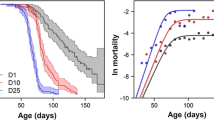Summary
Laboratory life table experiments were conducted using nine clones of obligately parthenogenetic Daphnia pulex that were collected from a site in the Canadian low-arctic. Two of the nine clones were diploids, while the other seven clones were polyploids. Significant clonal differences in age at first reproduction, size at first reproduction, number of offspring in each of the first three broods, offsrring sizes for the first two broods, and intrinsic rates of natural increase were detected. Differences in life histories were evident between polyploids and diploids. Generally, polyploid clones reached maturity at later ages, matured at larger sizes, produced smaller broods, and larger offspring than the diploid clones. The data are discussed in reference to potential biotic (i.e. invertebrate predation) and abiotic factors (i.e. physicochemical gradients) that may influence life history variation in this clonal assemblage.
Similar content being viewed by others
References
Beatty RA (1957) Parthenogenesis and polyploidy in mammalian development, Cambridge Monographs in Experimental Biology, no. 7, Cambridge Univ. Press, London
Cavalier-Smith T (1978) Nuclear volume control by nucleoskeletal DNA, selection for cell volume and cell growth, and the solution of the DNA C-value paradox. J Cell Sci 34:247–278
Dingle H, Hegmann JP (eds) (1982) Evolution and genetics of life histories, Springer-Verlag, New York
Dodson SI (1984) Predation of Heterocope septentrionalis on two species of Daphnia: morphological defenses and their cost. Ecology 65:1249–1257
Emery CJ (1984) The ecological impact of near ultraviolet radiation on Daphnia pulex. M.S. thesis, Univ. of Windsor
Falconer DS (1981) Introduction to quantitative genetics, 2nd edn. Longman, New York
Hebert PDN, Crease TJ (1980) Clonal coexistence in Daphnia pulex (Leydig): another planktonic paradox. Science 207: 1363–1365
Hebert PDN, Loaring JM (1980) Selective predation and the species composition of Arctic ponds. Can J Zool 58:422–426
Hebert PDN, McWalter DB (1983) Cuticular pigmentation in arctic Daphnia: adaptive diversification of asexual lineages? Amer Nat 122:286–291
Hebert PDN, Hann BJ (1986) Patterns in the composition of arctic tundra pond microcrustacean communities. Can J Fish Aquat Sci 43:1416–1425
Levin DA (1983) Polyploidy and novelty in flowering plants. Am Nat 122:1–25
Lewis WH (ed) (1980) Polyploidy: biological relevance, Basic Life Sciences, vol. 13. Plenum Press, New York
Lokki J, Saura A (1980) Polyploidy in insect evolution. In: Lewis WH (ed) Polyploidy: biological relevance, Plenum Press, New York, pp 277–312
Lynch M (1980) The evolution of cladoceran life histories. Quart Rev Biol 55:23–42
Lynch M (1982) Ecological genetics of Daphnia. Evol 37:358–374
Lynch M (1984) Destabilizing hybridization, general-purpose genotypes and geographic parthenogenesis. Quart Rev Biol 59:257–290
Lynch M, Ennis R (1983) Resource availability, maternal effects, and longevity. Experimen Gerontol 18:147–165
Lynch M, Weider LJ, Lampert W (1986) Measurement of the carbon balance in Daphnia. Limnol Oceanogr 31:17–33
McWalter DB (1981) Genetic variation and relatedness of asexual Daphnia species. M.S. thesis, Univ. of Windsor
Mooney HA, Johnson AW (1965) Comparative physiological ecology of an arctic and alpine population of Thalictum alpinum L. Ecology 46:721–727
Purdom CE (1976) Genetic techniques in flatfish culture. J Fish Res Bd Can 33:1088–1099
Ray AA (1982) SAS user's guide, Statistics 1982. SAS Institute, Cary, North Carolina
Reznick D (1982) The impact of predation on life history evolution in Trinidadian guppies: genetic basis of observed life history patterns. Evolution 36:1236–1250
Roughgarden J (1979) Theory of population genetics and evolutionary ecology: an introduction, MacMillan, New York
Schultz RJ (1982) Competition and adaptation among diploid and polyploid clones of unisexual fishes. In: Dingle H, Hegmann JP (eds) Evolution and genetics of life histories, Springer-Verlag, New York, pp 103–120
Schwartz SS, Hebert PDN (1986) Prey preference and utilization by Mesostoma lingua (Turbellaria, Rhabdocoela) at a low arctic site. Hydrobiol 135:251–257
Sokal RR, Rohlf FJ (1981) Biometry, 2nd edn. WH Freeman and Co., San Francisco
Stearns SC (1976) Life history tactics: a review of the ideas. Quart. Rev Biol 51:3–47
Stearns SC (1977) The evolution of life history traits: a critique of the theory and a review of the data. Ann Rev Ecol Syst 8:145–171
Tal M (1980) Physiology of polyploids. In: Lewis WH (ed) Polyploidy: biological relevance, Plenum Press, New York, pp 61–75
Tal M, Gardi I (1976) Physiology of polyploid plants: water balance in autotetraploid and diploid tomato under low and high salinity. Physiol Pl 38:257–261
Tal M, Heikin H, Dehan K (1978) Salt tolerance in the wild relatives of the cultivated tomato: responses of callus tissue of Lycopersicon esculentum, L. peruvianum, and Solanum pennellii to high salinity. Z Pflanzen 86:231–240
Weider LJ (1985) Spatial and temporal genetic heterogeneity in a natural Daphnia population. J Plankton Res 7:101–123
Weider LJ, Hebert PDN (1987a) Ecological and physiological differentiation among low-arctic clones of Daphnia pulex. Ecology 68:188–198
Weider LJ, Hebert PDN (1987b) Microgeographic genetic heterogeneity of melanic Daphnia pulex at a low-arctic site. Heredity 58:391–399
Author information
Authors and Affiliations
Rights and permissions
About this article
Cite this article
Weider, L.J. Life history variation among low-arctic clones of obligately parthenogenetic Daphnia pulex: a diploid-polyploid complex. Oecologia 73, 251–256 (1987). https://doi.org/10.1007/BF00377515
Received:
Issue Date:
DOI: https://doi.org/10.1007/BF00377515




